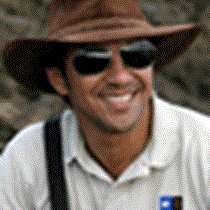To say that we started our day in a formidable way is an understatement! By five thirty in the morning, the light was already breaking through the horizon. The clouds at the distance received an unexpected shower of golden light, revealing all its shades and angles. The reflection of the forest over the glassy water was spectacular, and even at that early hour, some of us already had cameras in hand, ready for our first pictures!
The flavor of freshly-brewed coffee made the morning even better, and we were anxious to board our skiffs and head out for our pre-breakfast adventure.
We crossed the width of the Ucayali, as our destination was a further spot along the main river known for the amount of “aguaje” palm trees, which are used by the blue and yellow macaws as their nesting grounds. “The early bird catch its worm”, and we really did! Macaws were perched at the top of a dead stem from a former aguaje palm. As the morning light warmed the air, the macaws stretched and prepared for their daily commute to distant grounds for foraging. It was precisely at this time when we got them to see them in full action, as they pirouetted over the branches of the tree with astonishing accuracy.
We continued our exploration of the Ucayali, entering some of the small creeks formed by the massive amount of water flowing at this time of the year, forming the well-known floodplains of the Amazon Basin. We were eager to find more wildlife, and soon we encountered a noisy group of owl monkeys peaking over their well-camouflaged burrow in a tall tree.
As we continued, we encountered one of the most representative species of plants in the Amazon, the giant water lilies, known very well locally by its scientific name, Victoria amazonica. This beautiful plant, with its enormous leaves capable of supporting the weight of a small child, grows in side channels and standing bodies of water through much of the Amazonian floodplain. Precisely at sunset, a massive lotus-like flower bud rises slowly above the surface of the water. Triggered by the falling light, the flowers open rapidly, showing their exquisite and brilliant white petals. The flower’s fragrance, which had been growing in strength since early afternoon, reaches a peak of intensity. The same biochemical process that generates the scent also increases the temperature of the central part of the blossom by exactly 11 degrees Celsius above whatever the air temperature happens to be. The combination of color, odor, and heat attracts a swarm of beetles. As the temperature cools, the flower begin to close, trapping the beetles within the blossom. The next day, just before dusk, the male anthers release pollen, and the beetles, sticky with the juice of the flower and once again hungry, are finally allowed to go. Climbing over the anthers, the beetles become covered with pollen, which they then carry to the stigma of another flower, thus completing the flowers’ cycle.
As for the rest of the day, we continued to discover more wildlife as we explored the nearby creek known as Beluda Caño. This intricate ecosystem continued to disclose its secrets as we navigate on its dark waters, revealing visually with astounding precision the great biodiversity of the Amazonas!







